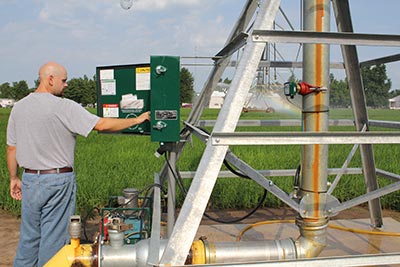 Soil properties such as texture, structure and infiltration impact water availability. Sandy soils usually have a lower available water holding capacity than loam and clay soils. Coarse textured soils hold less water and need to be irrigated more frequently to produce high yields. The U.S. Department of Agriculture Natural Resources Conservation Service (NRCS) web soil survey is a good resource for learning about soils in your field. Find the web soil survey at https://websoilsurvey.sc.egov.usda.gov/App/HomePage.htm.
Soil properties such as texture, structure and infiltration impact water availability. Sandy soils usually have a lower available water holding capacity than loam and clay soils. Coarse textured soils hold less water and need to be irrigated more frequently to produce high yields. The U.S. Department of Agriculture Natural Resources Conservation Service (NRCS) web soil survey is a good resource for learning about soils in your field. Find the web soil survey at https://websoilsurvey.sc.egov.usda.gov/App/HomePage.htm.
Farmers are advised to use a weather-based scheduling program or sensors that measure soil moisture for managing irrigation on all row crops. New technologies that monitor leaf canopy temperatures also look promising. The Crop Water Use app and Woodruff chart method use evapotranspiration based on weather data and track daily soil water balances in fields. Many types of soil moisture sensors are sold. Each has its strengths and weaknesses. Be sure the communication from moisture sensors in the field to your cellphone or computer is reliable before you purchase a system. Below is information for managing irrigation with corn, soybean, cotton and rice.
Corn
Water management for corn is affected by growth stage. Rapid vegetative growth occurs 60 to 65 days from germination until silks develop. Leaf development during this period is important for light interception and capturing energy for growth. Provide sufficient soil drainage to prevent plant stunting from waterlogging after heavy rains and minimize nitrogen losses from leaching and denitrification. Root depth affects plant access to stored soil water and irrigation trigger settings in water balance scheduling programs. Most of the corn roots occur in the upper 24 inches of soil. Soil compaction can limit root growth. In ideal conditions, maximum roots can grow down 5 feet. A critical time to avoid yield loss from water stress is grain fill, which begins about 2.5 weeks after silks form. Stop irrigating when the grain starch line is at least 50% of the kernels and soil moisture is good. If either condition is not met, apply another flood or furrow irrigation. If center pivot irrigation is used, apply two or three more times if rain does not occur.
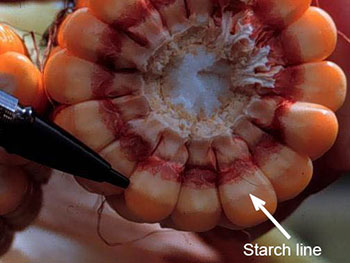

Soybean
Water use in soybean plants is slow in the early vegetative growth stages. At the fourth leaf stage, which is usually 40 to 45 days after planting, water use increases. The rate of daily evapotranspiration increases steadily until podding begins. Maximum water use occurs when the leaf canopy covers the soybean rows and roots are fully developed. After flowering begins, irrigation has less effect on plant height of determinate compared to indeterminate soybean varieties. Indeterminates soybean are varieties with main stems that nearly double in height and number of nodes after reproduction begins. The age of flower/pods/seeds vary greatly from bottom to top of plant.
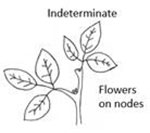
Indeterminate keeps producing pods
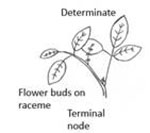
Determinate reaches height, then starts reproduction
Determinates are varieties with main stems that are nearly at maximum height when flowering begins. The “age” of flowers/pods/seeds are nearly the same from bottom to top of plant.
Cotton
Cotton is a perennial plant with an indeterminate growth habit. In production fields, farmers manage modern cotton varieties as annuals. Cotton flower buds are called squares. Squares, blooms, and bolls are fruit. A good fruit load on plants provides a carbohydrate sink to reduce excessive vegetative growth. Shedding of fruit can be caused by insects and factors such as population density, water, nitrogen, and disease. Mepiquat chloride applications can also be used to help control plant height. Irrigation management is especially important during the 75 to 105 days of reproductive growth. Late in season cotton plants start to “cut-out”. New squares may be produced but there are not enough days left in the growing season for them to mature. Blooms can often be seen in the top nodes of the cut-out plants. Missouri is in the northern part of the Cotton Belt. Dr. Bobby Phipps was the former cotton specialist at the Fisher Delta Center. His research showed that irrigations should stop on August 15, assuming soil moisture was good at that time. Most years there are not enough warm days after mid-August to mature new fruit that would result from late irrigations.
Shown below are the first five reproductive stages of cotton.
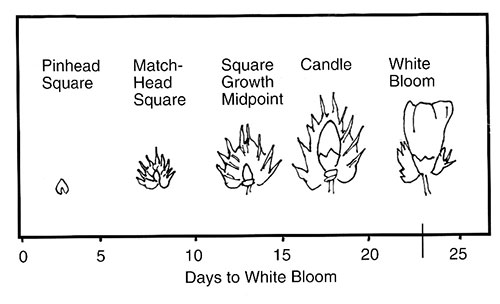
Rice
Rice requires more water than any other crop grown in Missouri. Most fields are irrigated by the cascade flood method with levee gates adjusted to maintain 2 to 4 inches of water depth across fields. Fields are divided by levees into pans, with levees placed according to field slope. The steeper the slope, the closer levees are spaced and more levees needed per field. Irrigation water is pumped in the upper field pan and overflows into the next pan through the levee gates. Water continues to cascade over each consecutive levee gate, then out into the bottom tail ditch. Land preparation for cascade flooding is labor-intensive.
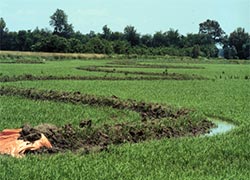
Cascade flooding of rice field
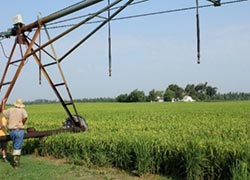
Center pivot irrigation of rice field
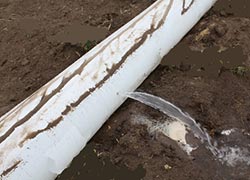
Furrow irrigation of rice field
Southeast Missouri farmers were among the first growers in the United States to adopt furrow-irrigated rice production, which does not require levees. Rice is normally rotated with soybeans. With furrow irrigated rice, less land preparation is needed in the soybean rotation year because rice levees do not need to be taken down. The rice beds can be used for soybeans the following year. In some rice fields, soils with low clay content or sand boils do not efficiently retain floodwater. In these fields, furrow or center pivot irrigation would be the best options for rice production.
Farmers with flood irrigation pump water on the top pan of a field long enough for it to go through the system of gates to fill the lower pans. Managing pumps is tricky. In addition, electric power companies discourage running pumps during peak hours. A delay of several hours can occur between the time the pump is shut off and the water cascades to the bottom pan. Despite a farmer’s best effort, inevitably, the pump is often left on too long and water is wasted. A variation of the flood method is side-inlet, which uses lay-flat plastic pipe placed at the field edge or across the levees to fill pans all at the same time. Less guess work with stopping the pump is needed with this method. A demonstration by the NRCS in 1998 showed that side-inlet saved 39% energy and 60% irrigation water compared to cascade.